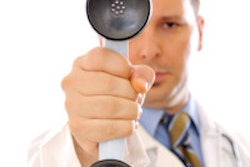
Disruptive behavior among clinicians and residents is not only time-consuming and potentially dangerous, it's expensive, with costs per hospital potentially reaching into the millions per year, according to a new report in Academic Radiology.
How widespread is the problem? A recent survey found that 70% of clinicians faced disruptive behavior in their facilities on at least a monthly basis, with episodes ranging from demeaning treatment of colleagues to throwing chairs, with or without substance abuse, wrote radiologists from the Medical College of Georgia and the University of Florida.
The costs associated with physician turmoil are manifested in myriad ways and can be difficult to calculate. But the team took a stab at it based on costs detailed in the literature, and found a massive -- and expensive -- problem.
In one 400-bed hospital, for example, the combined costs due to staff turnover, medication errors, and procedural errors exceeded $1 million per year.
"What this study shows is that disruptive physician behavior isn't bringing any value to patients or patient outcomes, and it also shows that disruptive physician behaviors are actually costing dollars, and that there's a real economic burden," lead author Dr. James Rawson, from the Medical College of Georgia, told AuntMinnie.com.
Indeed, by improving the understanding of disruptive conditions and creating policies to manage them consistently, "medical errors as well as healthcare and academic expenses can be reduced," the study team wrote (Academic Radiology, September 2013, Vol. 20:9, pp. 1074-1076).
Measuring the impact
It was actually the Joint Commission that started measuring the effects of disruptive physician behavior in 2008 with its Sentinel Event Alert No. 40, a missive that aimed to link disruptive behavior to medical errors, patient dissatisfaction, preventable adverse outcomes, higher staff turnover, and higher costs of care and malpractice insurance. To address the problem, the Joint Commission recommended that hospitals establish a formal code of conduct, and that leaders create a process for "reporting, evaluating, and managing" disruptive behavior, Rawson and colleagues wrote.
The Joint Commission's recommendations were encapsulated in a new leadership standard (LD.03.01.01) containing two elements of performance: First, hospitals and organizations should maintain a code of conduct that defines disruptive and inappropriate behavior, and second, leaders should implement a process for addressing such disruptive behavior, which includes the following acts:
- Anger outbursts
- Throwing
- Demeaning
- Physical violence
- Sexual harassment
- Racial/ethnic jokes
- Alcohol or drug abuse
- Chronic tardiness
- Ignoring pages/calls
- Ignoring questions, warnings, and suggestions
- Derogatory comments
- Refusal to follow policy
- Body language -- eye rolling
Classic disruptive behaviors such as profanity or throwing objects have always been seen as such, but other behaviors such as chronic tardiness or refusing to follow policies can also be disruptive. Falling asleep in lectures or not participating in discussions could be considered passive-aggressive destructive behaviors, the authors wrote.
In a 2011 survey of 840 physicians, 70% reported that disruptive behaviors occurred at least once per month, and 10% said they occurred daily, according to Rawson and colleagues. Half said that patients had changed physicians or left a practice due to such behavior, and more than 25% of the physicians said they had engaged in disruptive behaviors themselves at some point.
What are the causes of disruptive behavior? About one-fifth of the general population suffers from mental illness each year, and most of the illnesses, except for schizophrenia, are as common among physicians as in the general population, the authors wrote. In addition, some 10% to 12% of physicians develop a substance use disorder, about the same level as in the general population.
Incidence and effect on clinical care
Disruptive behavior can result in staff turnover, medical errors, and preventable procedural complications. Overall, about 12% of all hospital staff departures are due to disruptive behaviors.
One survey found that 2.4 nurses per year left a hospital due to disruptive behaviors, and others have estimated that employee turnover costs 200% of the salary for the job, Rawson and colleagues wrote. In addition, 7% of medication errors have been attributed to dysfunctional behaviors.
Disruptive behavior also affects medical education. "Faculty members exhibiting angry outbursts and profanity but bringing in a large amount of revenue to the department pose unique challenges," they wrote. "The result is decreased morale in the department and a less conducive environment for learning."
 Dr. James Rawson, from the Medical College of Georgia.
Dr. James Rawson, from the Medical College of Georgia.In the 2011-2012 Accreditation Council for Graduate Medical Education (ACGME) resident survey, 18% of residents said they "could not raise concerns without fear of reprisal," the group noted. Among the more than 9,000 graduate medical education programs in the U.S., one hypothetical disruptive physician interrupting two hours of education a week would be the equivalent of 10 additional full-time faculty members.
On the other side of the coin, radiology residents can also demonstrate disruptive behavior, particularly with respect to substance abuse. An estimated 15% of a program director's time is needed to support a single impaired resident, excluding downstream costs such as the impact on other faculty, residents, or staff.
The support time required for troubled residents can be measured, but other costs of disruptive behavior cannot, Rawson acknowledged.
"When we were designing the study, we were struggling to capture all costs, so what we did is go after things that there were data on and that we could model," Rawson told AuntMinnie.com. "The impact of disruptive behavior on education and resident education is harder to measure. But some of the survey data that we included I think does show that there are problems with disruptive behavior for both residents and medical students."
In terms of future research, Rawson said he would like to build a simulation model that looks at changes in practice and their effects on clinical outcomes for patients, as well as financial outcomes.
"You could build an economic model that would simulate a hospital in more detail and measure improvements as well as worsening of disruptive behavior," Rawson said.
What's clear already is that disruptive physicians affect the healthcare system adversely, and the high rate of disruptive behavior produces a strong multiplier effect, the team wrote. Improving understanding and developing policies to manage disruptive behavior will help reduce both medical errors and healthcare and academic expenses.
"To decrease the impact on patient outcomes and the economics, you want to not only have policies that people are aware of and that they follow, you also want to be proactive in terms of your education," Rawson said. "One of the tools that's available to reduce disruptive physician behavior is actually education: training people on what is disruptive, and showing them what the impact is."
Managers also need to give patients tools on how to manage and report disruptive behaviors.
"But to a large extent it's education and training -- and raising awareness," he concluded.



















